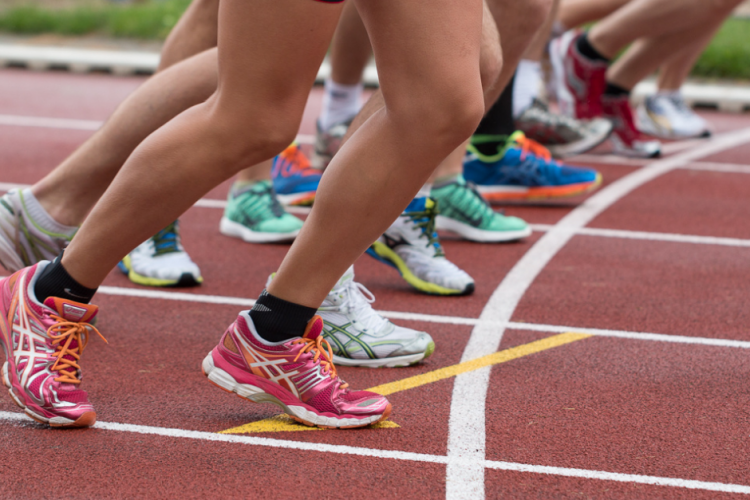
On your marks. Set. WAIT! Wait, wait, wait! I think you’re getting a little ahead of yourself here.
Have you done anything to prepare for this? Unfortunately, running isn’t as easy as popping those spikes on and standing at the start line. That’s a great way for you to head straight to the closest medical tent! So before that happens I thought I would provide 5 ways to prevent injury this Little Athletics season.
Warm up
Now this sounds obvious! Who doesn’t warm up before running! Well, believe it or not there is a proper way to warm up. But before I get into that, what does warming up actually do?
Warming up causes the body to divert blood, oxygen and nutrients to the muscles allowing them to contract and function safely and effectively. It also removes waste products and raises your body temperature which warms up your muscles and joints.
Now, how do you warm up properly? Perform movements that reflect the event you are competing in. There is no point in doing a push up when you’re about to compete in the high jump. However if you were about to perform a shot put, a push up would be quite relevant, as it uses the same muscles and are very similar movements to each other.
Dont static stretch!
WHAT! You stretch all the time, what’s so wrong with it?
Now don’t get me wrong, stretching is awesome for relieving all those muscles aches and reducing tension, but before intense physical exercise or maximal effort events, research has shown that static stretching can have a negative effect on performance and can also increase the likelihood of injuring yourself!
So what do you do instead?
Well believe it or not there are multiple forms of stretching! Dynamic Stretching is the best and easiest form of stretching that has been shown to increase blood flow, gently lengthen muscles and achieve the highest output from your muscles during intense exercise.
Well then, how do I perform dynamic stretching?
Simple movements like high knees, butt kicks, quick feet and walking lunges are all considered dynamic stretches.
Exercise before you exercise?
What do you mean to exercise before you exercise? Isn’t that basically what you have just talked about? Well, yes but also no.
What we discussed previously is exercise, but it has been a preparation phase. Getting the muscles and joints warm, increasing blood flow is what our previous two points have been about. What I mean here is actually performing the movement or the event before you perform it for real. This is typically referred to as a run through. To perform them you start off at a slow pace then over 3-4 run throughs you build up to your 100%. This is both a mental preparation and a physical one as you move through all the stages of the race, throw or jump. It solidifies what you need to do and physically prepares those muscles most under pressure.
Now you are ready to run!
Cool down
Come on man, I’m tired! can’t I just go home?
Ha, well yeah… if you want! But then you probably feel pretty sore tomorrow!
Everyone has felt it. Had a massive day of exercise the day before and when you wake up, Arrgghh! Joints creaking, muscles on fire and you have to walk around like a penguin until you loosen up a bit. After exercise toxins and damaging substances build up and are stored in the muscles and joints. Now this isn’t completely unavoidable, but it can be significantly reduced by performing a cool down at the end of your carnival. What a cool down does is allows oxygenated blood to perforate the muscles and joints, flushing out the toxins and allowing them to be broken down. Now to perform a cool down you mirror what you did in your warm up. This allows the heart rate to return to normal and the body temperature to reduce in a gradual way preventing that nasty build up of toxins.
Ok well this is cool but what about static stretching? Can I do it now?
Yeah you can!
Static stretching at the end of your cool down is the best time to perform it! It allows further cooling of your body temperature to normal levels and helps to prevent post exercise cramping by lengthening out the muscles.
Hydration
Now hydration may be number 5 on this list however it is the most important not just for exercise but for everyday life. Up to 60% of our body is composed of water and without adequate intake our body suffers.
But how does it help prevent injury? Adequate hydration allows our heart to pump blood around our body more easily and efficiently, meaning more oxygen and nutrients reach the muscles keeping them functioning at 100%. Our muscles need water as well, every muscle is made up of millions of cells each requiring water to maintain their strength and durability. Without water these cells dry out, becoming brittle.
There are many factors that contribute to injury, and even with the best preparation injuries are still a possibility. The main point is to incorporate an exercise routine that is relevant to your sport and ensure you warm up effectively to significantly reduce your chance of an injury this season.
On your marks. Set. GO!
You will find Ben down on the track with Northern Suburbs Little Athletics this season, helping athletes perform at their best this season.

